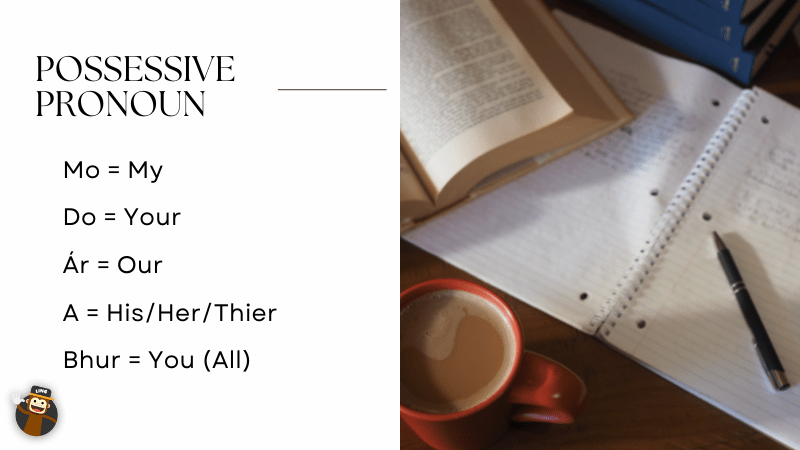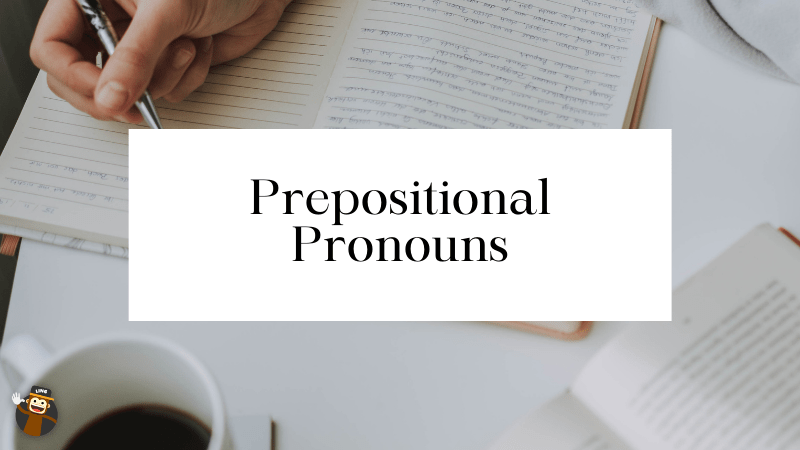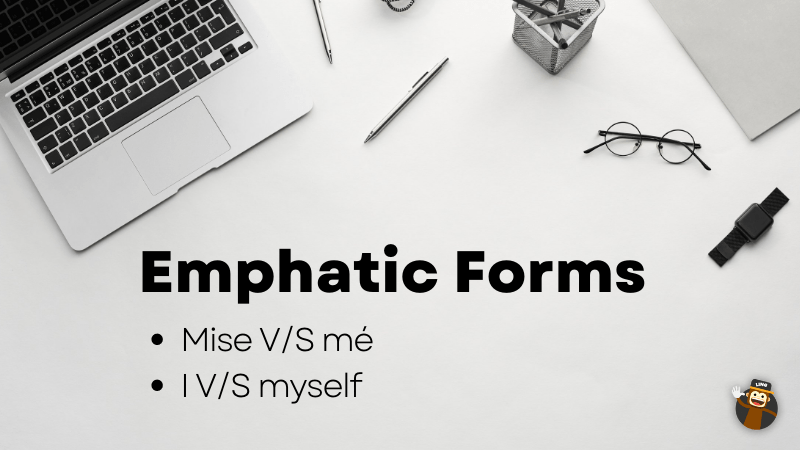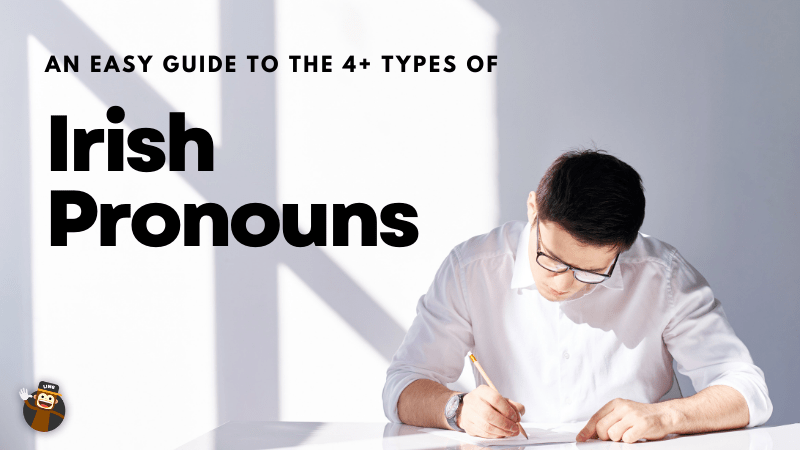Learning a new language is not just about memorizing words and basic expressions to sound local. Learning complex grammar rules is a must if you genuinely want to make sense. There’s nothing more that we can recommend for beginners than starting with the basics of Irish pronouns. Today’s post will walk you through all the pronouns and their conjugations. We have broken down related grammatical rules with easy examples to master this topic in no time. Take your notebook and pen out, and let the learning begin!
![]() Irish Grammar
Irish Grammar
Irish grammar comprises various elements in a sentence, and one of those elements is its pronouns. We all know the cliche definition of a pronoun: a pronoun is a word that takes the place of a noun in a sentence. The use of pronouns in Irish grammar is essential because several conjugations are associated with them.
For instance, “Sarah is my sister. She is nice”. We talk about the same person in these two sentences but use different words. Sarah is the girl’s name, but using the same name when we want to talk more about her can make it redundant, which is why we replace the noun, i.e., “Sarah,” with a pronoun, i.e., “she.”
In Irish, pronouns are known as “Forainmneacha.” Here is a table showing Irish pronouns along with example sentences:
| Irish Pronouns | English Translations | Irish Sentences | English Translations |
| Mé | I | Tá mé gleoite | I am cute |
| Tú | You | Tá tú gleoite | You are cute |
| Sé | He | Tá sé gleoite | He is cute |
| Sí | She | Tá sí gleoite | She is cute |
| Sinn | We | Tá sinn gleoite | We are cute |
| Siad | They | Tá siad gleoite | They are cute |
Subject Pronoun
A pronoun is generally referred to as a subject pronoun. A subject pronoun is called “forainm ábhair” in Irish. In most cases, the noun being replaced by a pronoun is the subject of the sentence, which is why it’s called a subject pronoun.
Sarah was the subject in the sentence mentioned above, and a pronoun replaced her name. But the word “she” was still the subject of the sentence, and that is why that pronoun is called the subject pronoun.
Possessive Pronoun

A possessive pronoun is a pronoun that shows the quality of possession in a sentence. For instance, in the sentence “this is my dog,” the pronoun “my” is a possessive pronoun since it shows that a person/thing possesses the dog.
In Irish, possessive pronouns are called “forainmneacha sealbhacha.” The table below shows the possessive pronouns in Irish:
| Irish Pronouns | English Translations |
| Mo | My |
| Do | Your |
| Ár | Our |
| A | His |
| A | Her |
| A | Their |
| Bhur | You (All) |
Possessive pronouns are conjugated differently for both singular and plural nouns. For both singular and plural nouns, the lenition is based on the alphabet that the word starts with. In the case of words starting with a vowel, the conjugation is different. The same goes for the words beginning with consonants.
L, m, n, r, and s are some alphabets that are not lenited. If any word starting with these alphabets is written with the pronouns, then it is written as it is unless some exceptions.
Singular Words (Vowels)
The possessive pronouns in Irish are conjugated with the nouns if nouns start with vowels. There are some rules for singular words that start with vowels and are as follows with examples:
- To conjugate a singular word starting with a vowel with the possessive pronoun mo (my), we omit the o and replace it with an apostrophe and write the word with it. For instance, the word for the name in Irish is “ainm”. The possessive pronoun for my name will be “m’ainm”; m’-word.
In English, this can also be observed where an apostrophe is added to a word to show possession. For instance, “dog’s hair”, etc.
- To conjugate such words with the possessive pronoun do (your), the same phenomenon happens. O gets omitted and replaced by an apostrophe and the word. For instance, the word for the almond in Irish is “almón”. The possessive pronoun for your almond will be “d’almón”; d’-word.
- To conjugate, such words with the possessive pronoun ár (our), “n” is added to the main word. For instance, the word for the sauce in Irish is “anlann”. The possessive pronoun for our sauce will be “ár n-anlann”; ár+n-word
- To conjugate, such words with the possessive pronoun a (his), the pronoun “a” is written with the word. For instance, the word for the grave in Irish is “uaigh”. The conjugation for his grave will be “a uaigh” a+word
- To conjugate, such words with the possessive pronoun a (her), “h” is added to the main word. For instance, the word for the magazine in Irish is “irisliabhar”. The conjugation for her magazine will be “a h-irisliabhar”; a+h-word .
- To conjugate, such words with the possessive pronoun a (their), “n” is added to the main word. For instance, the word for the worker in Irish is “oibrí”. The conjugation for her magazine will be “a n-oibrí”; a+n-word.
- To conjugate, such words with the possessive pronoun bhur (your), “n” is added to the main word. For instance, the word for treasure in Irish is “ulaidh”. The conjugation for your treasure will be “bhur n-ulaidh”; bhur+n-word.
Here is a table with the possessive pronouns conjugated with words starting with a vowel along with their examples:
| Irish Conjugations | English Translations |
| M’ainm | My name |
| D’ainm | Your name |
| A Ainm | His name |
| A H-Ainm | Her name |
| A N-Ainm | Their name |
| Bhur N-Ainm | Your (all) name |
| Ár N-Ainm | Our name |
| M’almón | My almond |
| D’almón | Your almond |
| Ár N-Almón | Our almond |
| A Almón | His almond |
| A H-Almón | Her almond |
| A N-Almón | Their almond |
| Bhur N-Almón | Your (all) almond |
| M’anlann | My sauce |
| D’anlann | Your sauce |
| Ár N-Anlann | Our sauce |
| A Anlann | His sauce |
| A H-Anlann | Her sauce |
| A N-Anlann | Their sauce |
| Bhur N-Anlann | Your (all) sauce |
| M’uaigh | My grave |
| D’uaigh | Your grave |
| Ár N-Uaigh | Our grave |
| A Uaigh | Their |
| A H-Uaigh | Her grave |
| A N-Uaigh | Their grave |
| Bhur N-Uaigh | Your (all) grave |
| M’eàrr | My section |
| D’eàrr | Your section |
| Ár N-Eàrr | Our section |
| A Eàrr | Their section |
| A H-Eàrr | Her section |
| A N-Eàrr | Their section |
| Bhur N-Eàrr | Your (all) section |
| M’irisliabhar | My magazine |
| D’irisliabhar | Your magazine |
| Ár N-Irisliabhar | Our magazine |
| A Irisliabhar | Their magazine |
| A H-Irisliabhar | Her magazine |
| A N-Irisliabhar | Their magazine |
| Bhur N-Irisliabhar | Your (all) magazine |
| M’oibrí | My worker |
| D’oibrí | Your worker |
| Ár N-Oibrí | Our worker |
| A Oibrí | Their worker |
| A H-Oibrí | Her worker |
| A N-Oibrí | Their worker |
| Bhur N-Oibrí | Your (all) worker |
| M’ulaidh | My treasure |
| D’ulaidh | Your treasure |
| Ár N-Ulaidh | Our treasure |
| A Ulaidh | Their treasure |
| A H-Ulaidh | Her treasure |
| A N-Ulaidh | Their treasure |
| Bhur N-Ulaidh | Your (all) treasure |
Singular Words (Consonants)
Each pronoun is conjugated in a different way for the words starting with a singular consonant.
- To conjugate a singular word starting with a consonant with the possessive pronoun mo (my), add an “h” after the consonant of the word. For instance, the word for the son in Irish is “mac”. The possessive pronoun for my name will be “mo mhac”; mo+h after first consonant in the word.
- To conjugate such words with the possessive pronoun do (your), add an “h” after the consonant of the word. For instance, the word for tree in Irish is “crann”. The possessive pronoun for your tree will be “do chrann”; do+h after first consonant in the word.
- To conjugate such words with the possessive pronoun Ár (our), add and m before the consonant. For instance, the word for student in Irish is “dalta”. The possessive pronoun for our student will be “Ár mdalta”; ár+m-word.
- To conjugate such words with the possessive pronoun A (their), add an m before the consonant. For instance, the word for vote in Irish is “vóta”. The possessive pronoun for their vote will be “A vóta”; a+m-word.
- To conjugate a singular word starting with a consonant with the possessive pronoun A (his), add an “h” after the consonant of the word. For instance, the word for the train in Irish is “traein”. The possessive pronoun for his train will be “A thraein”; a+h after the first consonant of the word.
- Conjugating the pronoun a “her” is relatively simple as the pronoun is added before the word. For instance, the word for the school in Irish is “scoil”. The possessive pronoun for her school will be “A scoil”; a+word.
- And finally to conjugate Bhur (ya’ll) you can simply follow what you did with Ár (our) and A (their), you can add and m before the consonant. For instance, the word for the dress in Irish is “gúna”. The possessive pronoun for her school will be “Bhur mgúna”; bhur+m-word.
Here is a table with the possessive pronouns conjugated with words starting with a consonant along with their examples:
| Irish words | English Translations |
| Mo mhac | My son |
| Do mhac | Your son |
| Ár mac | Our son |
| A mhac | Their son |
| A mac | Her son |
| A mac | Their son |
| Bhur mac | Your (all) son |
| Mo scoil | My school |
| Do scoil | Your school |
| Ár scoil | Our school |
| A scoil | Their school |
| A scoil | Her school |
| A scoil | Their school |
| Bhur scoil | Your (all) school |
| Mo chrann | My tree |
| Do chrann | Your tree |
| Ár mcrann | Our tree |
| A mcrann | Their tree |
| A chrann | His tree |
| A crann | Her tree |
| Bhur mcrann | Your (all) tree |
| Mo dhalta | My student |
| Do dhalta | Your student |
| Ár mdalta | Our student |
| A mdalta | Their student |
| A dhalta | His student |
| A dalta | Her student |
| Bhur mdalta | Your (all) student |
| Mo vhóta | My vote |
| Do vhóta | Your vote |
| Ár mvóta | Our vote |
| A mvóta | Their vote |
| A vhóta | His vote |
| A vóta | Her vote |
| Bhur mvóta | Your (all) vote |
| Mo thraein | My train |
| Do thraein | Your train |
| Ár mtraein | Our train |
| A mtraein | Their train |
| A thraein | His train |
| A traein | Her train |
| Bhur mtraein | Your (all) train |
| Mo ghúna | My dress |
| Do ghúna | Your dress |
| Ár mgúna | Our dress |
| A mgúna | Their dress |
| A ghúna | His dress |
| A gúna | Her dress |
| Bhur mgúna | You’re (all) dress |
Many learners add another “m” or “h” to the words which are wrong. If a word has an “h” as a second alphabet then it does not need to conjugate in the case of Mo, do, and a (my, your, and his). Similarly having a word that starts with m does not require another “m” to be added to it in the case of ár, a, and Bhur (our, their, and ya’ll’s).
Plural Words
I know you must be tired of learning all those baffling conjugations in the case of vowels and consonants. One way of conjugating the possessive pronouns with plural words is using “cuid.” Cuid roughly translates to some or share. Well, guess what? It’s not the same in the case of plurals.
There is no difference in the words (having vowels and consonants) because these are not conjugated here. Many people make the mistake of conjugating the words as well since they have practiced to do so with all other cases. But it is important to remember not to conjugate the words.
Conjugations are only for the term “cuid,” and you can learn them quickly. Here is how to conjugate each possessive pronoun using “cuid.”
- For mo, do and a (my, your, his) an “h” is added after c in cuid these making it “chuid”. For instance, saying mo chuid uisce means “my (share of) water”. Similarly, “do chuid uisce” and “a chuid uisce” means “your water and his water”.
- For Bhur, ár and a (ya’all, our and their) a “g” is added before cuid thus making it “gcuid”. Ya’ll’s water, our water and their water will become “bhur gcuid uisce”, “ár gcuid uisce” and “a gcuid uisce”.
- For A (her) no conjugations are needed and the word is written as it is. Her water will become “a cuid uisce”
*Note: Cuid is usually used for uncountable nouns e.g liquid. It can also be used for all the things/ people which are in the form of a group but can be separated. Cuid cannot be used with things/ people who show a sense of permanency, such as body parts and family members. It should not be used for anything that is an inherent belonging of a person.
Prepositional Pronouns

Prepositional pronouns are the pronouns that deal with the spatial and temporal directions of something. There are different prepositions, for example, on, under, above, etc. Prepositional pronouns are written right next to the prepositions, and that is why they have this name.
Here are some examples with prepositional pronouns and their usage for you to learn from:
| Irish sentences | English Translations | Prepositional pronouns | English Translations |
| Tá sé liom. | He is with me. | liom | With me |
| Tá mé leis. | I am with him. | leis | With him |
| Tá sé léi. | He is with her. | léi. | with her |
| Tá sí leo. | She is with them. | leo | with them |
| Tá siad linn. | They are with us. | linn | with us |
| Tá muid leat. | We are with you. | leat | with you |
| Tá muid libh. | We are with you (all). | Libh | with you (all) |
| Tá sé orm. | It is on me. | orm. | on me |
| Tá sé ort. | It is on you. | ort. | on you |
| Tá sé orainn. | It is on us. | orainn. | on us |
| Tá sé uirthi. | It is on her. | uirthi. | on her |
| Tá sé air. | It is on him. | air. | on him |
| Tá sé orthu. | It is on them. | orthu. | on them |
| Tá sé oraibh. | It is on you (all). | oraibh. | on ya’ll |
| Tábhachtach dom. | Important to me. | dom | to me. |
| Tábhachtach duit. | Important to you. | duit | to you |
| Tábhachtach di | Important to her | di | to her |
| Tábhachtach dó | Important to him | dó | to him |
| Tábhachtach dúinn | Important to us | dúinn | to us |
| Tábhachtach dóibh. | Important to them. | dóibh | to them |
Emphatic Forms

The emphatic form of pronouns is the form in which the emphasis is on the pronouns themselves. For instance, myself, himself, etc. are some of the emphatic pronouns. The following are the emphatic pronouns in the Irish language with examples:
| Irish Sentences | English Translation |
| Tá mise go dona | I myself am bad |
| Tá tusa go dona | You, yourself, are bad |
| Tá muidne go dona | We, ourselves, are bad |
| Tá seisan go dona | He, himself, is bad |
| Tá sise go dona | She, herself, is bad |
| Tá siadsan go dona | They, themselves, are bad |
| Tá sibhse go dona | You (all), yourselves, are bad. |
*Note: The word dona means bad in Irish.
Wrapping Up

If you liked this blog, feel free to check out other blogs on Ling App by Simya Solutions. We also have blogs on sentences in Irish and Irish verbs. I hope by now you can quickly tell what’s yours and what’s not with the help of Irish pronouns.
The Ling app has different creative ways for you to learn any language. You can check each link out to make notes on other languages. It is essential to enjoy learning because that helps one retain the information better.
Happy learning!





















